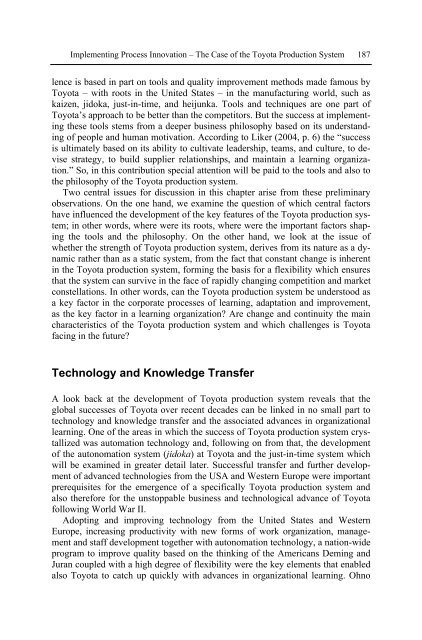Management of Technology and Innovation in Japan
Management of Technology and Innovation in Japan
Management of Technology and Innovation in Japan
Create successful ePaper yourself
Turn your PDF publications into a flip-book with our unique Google optimized e-Paper software.
Implement<strong>in</strong>g Process <strong>Innovation</strong> – The Case <strong>of</strong> the Toyota Production System 187<br />
lence is based <strong>in</strong> part on tools <strong>and</strong> quality improvement methods made famous by<br />
Toyota – with roots <strong>in</strong> the United States – <strong>in</strong> the manufactur<strong>in</strong>g world, such as<br />
kaizen, jidoka, just-<strong>in</strong>-time, <strong>and</strong> heijunka. Tools <strong>and</strong> techniques are one part <strong>of</strong><br />
Toyota’s approach to be better than the competitors. But the success at implement<strong>in</strong>g<br />
these tools stems from a deeper bus<strong>in</strong>ess philosophy based on its underst<strong>and</strong><strong>in</strong>g<br />
<strong>of</strong> people <strong>and</strong> human motivation. Accord<strong>in</strong>g to Liker (2004, p. 6) the “success<br />
is ultimately based on its ability to cultivate leadership, teams, <strong>and</strong> culture, to devise<br />
strategy, to build supplier relationships, <strong>and</strong> ma<strong>in</strong>ta<strong>in</strong> a learn<strong>in</strong>g organization.”<br />
So, <strong>in</strong> this contribution special attention will be paid to the tools <strong>and</strong> also to<br />
the philosophy <strong>of</strong> the Toyota production system.<br />
Two central issues for discussion <strong>in</strong> this chapter arise from these prelim<strong>in</strong>ary<br />
observations. On the one h<strong>and</strong>, we exam<strong>in</strong>e the question <strong>of</strong> which central factors<br />
have <strong>in</strong>fluenced the development <strong>of</strong> the key features <strong>of</strong> the Toyota production system;<br />
<strong>in</strong> other words, where were its roots, where were the important factors shap<strong>in</strong>g<br />
the tools <strong>and</strong> the philosophy. On the other h<strong>and</strong>, we look at the issue <strong>of</strong><br />
whether the strength <strong>of</strong> Toyota production system, derives from its nature as a dynamic<br />
rather than as a static system, from the fact that constant change is <strong>in</strong>herent<br />
<strong>in</strong> the Toyota production system, form<strong>in</strong>g the basis for a flexibility which ensures<br />
that the system can survive <strong>in</strong> the face <strong>of</strong> rapidly chang<strong>in</strong>g competition <strong>and</strong> market<br />
constellations. In other words, can the Toyota production system be understood as<br />
a key factor <strong>in</strong> the corporate processes <strong>of</strong> learn<strong>in</strong>g, adaptation <strong>and</strong> improvement,<br />
as the key factor <strong>in</strong> a learn<strong>in</strong>g organization? Are change <strong>and</strong> cont<strong>in</strong>uity the ma<strong>in</strong><br />
characteristics <strong>of</strong> the Toyota production system <strong>and</strong> which challenges is Toyota<br />
fac<strong>in</strong>g <strong>in</strong> the future?<br />
<strong>Technology</strong> <strong>and</strong> Knowledge Transfer<br />
A look back at the development <strong>of</strong> Toyota production system reveals that the<br />
global successes <strong>of</strong> Toyota over recent decades can be l<strong>in</strong>ked <strong>in</strong> no small part to<br />
technology <strong>and</strong> knowledge transfer <strong>and</strong> the associated advances <strong>in</strong> organizational<br />
learn<strong>in</strong>g. One <strong>of</strong> the areas <strong>in</strong> which the success <strong>of</strong> Toyota production system crystallized<br />
was automation technology <strong>and</strong>, follow<strong>in</strong>g on from that, the development<br />
<strong>of</strong> the autonomation system (jidoka) at Toyota <strong>and</strong> the just-<strong>in</strong>-time system which<br />
will be exam<strong>in</strong>ed <strong>in</strong> greater detail later. Successful transfer <strong>and</strong> further development<br />
<strong>of</strong> advanced technologies from the USA <strong>and</strong> Western Europe were important<br />
prerequisites for the emergence <strong>of</strong> a specifically Toyota production system <strong>and</strong><br />
also therefore for the unstoppable bus<strong>in</strong>ess <strong>and</strong> technological advance <strong>of</strong> Toyota<br />
follow<strong>in</strong>g World War II.<br />
Adopt<strong>in</strong>g <strong>and</strong> improv<strong>in</strong>g technology from the United States <strong>and</strong> Western<br />
Europe, <strong>in</strong>creas<strong>in</strong>g productivity with new forms <strong>of</strong> work organization, management<br />
<strong>and</strong> staff development together with autonomation technology, a nation-wide<br />
program to improve quality based on the th<strong>in</strong>k<strong>in</strong>g <strong>of</strong> the Americans Dem<strong>in</strong>g <strong>and</strong><br />
Juran coupled with a high degree <strong>of</strong> flexibility were the key elements that enabled<br />
also Toyota to catch up quickly with advances <strong>in</strong> organizational learn<strong>in</strong>g. Ohno


